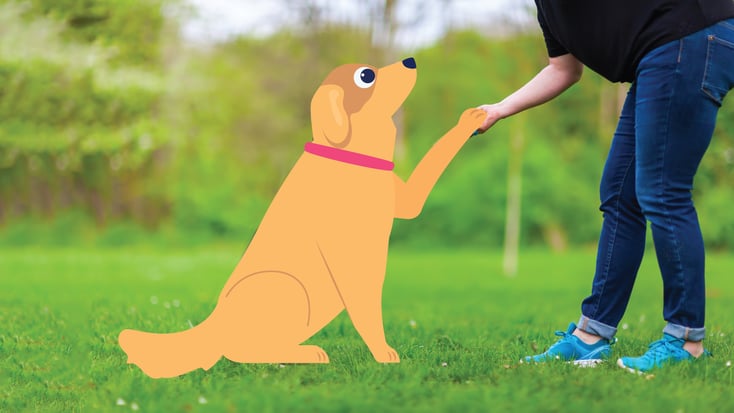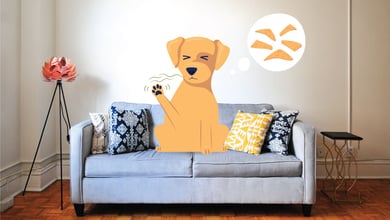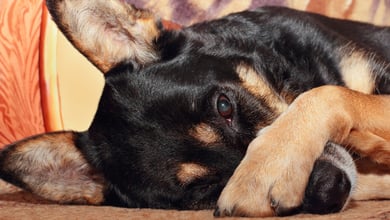Why Do Dogs Put Their Paws on You?

Table of Contents
Dogs possess a unique way of communicating, and one behavior that holds a special place in our hearts is when they paw us. Whether it's a gentle tap or a persistent nudge, this gesture goes beyond a simple display of affection.
Let's explore the intriguing language of dogs as we decipher the messages conveyed through their paws. It's a silent conversation filled with love, trust, and an innate longing for connection.
1. Communication and Affection
Dogs often use their paws to communicate and display affection towards their human companions. By placing their paws on us, they are attempting to establish physical contact and create a deeper connection.
It's their way of saying, "I love you" or "I want to be close to you.” This behavior is especially common during moments of relaxation or when seeking comfort and reassurance.
Related Reading: How to Read Your Dog's Body Language: 6 Tips
2. Seeking Attention
Dogs are social animals and crave attention from their owners. When they place their paws on us, it's often a way of seeking our undivided focus. They might nudge us with their paws or gently tap us to grab our attention. By doing so, they hope to initiate playtime, receive a belly rub, or enjoy some quality time together.
3. They are Requesting Something
Dogs are quick to learn that certain actions lead to desirable outcomes. When they place their paws on us, it can be a way of making a request. For example, if a dog puts their paw on your leg while you're eating, they may be hoping for a share of your food.
It could also indicate a desire to go outside for a walk or to play with their favorite toy. Dogs use their paws as a means of communication to convey their needs and wants.
4. Displaying Dominance
Sometimes, dogs may put their paws on us to assert dominance. This behavior is more commonly observed in dogs that have not received proper socialization or training. By placing their paws on our bodies, they are attempting to establish themselves as the dominant member of the pack.
This behavior may be accompanied by other signs such as a stiff body posture, direct eye contact, body blocking, growling, or raised hackles. It's essential to address this behavior with proper training techniques to ensure a harmonious relationship with your dog.
5. Anxiety or Stress
Dogs may put their paws on us when they feel anxious or stressed, such as during fireworks displays, visits to the veterinarian, or when there are loud noises like construction work or sirens. It can be a self-soothing mechanism, as physical contact helps to provide a sense of security and comfort.
If you notice this behavior frequently or in specific situations, it's important to address their underlying stressors and provide the necessary support and reassurance to help them navigate those challenging moments.
6. Training and Reinforcement
Unintentional reinforcement from owners can contribute to dogs repeatedly pawing at them. When a dog paws at their owner and receives attention, such as petting or verbal interaction, it reinforces the behavior. Dogs are quick learners, and if they associate pawing with getting the desired attention or response, they are likely to continue this behavior.
To address this, it's essential to avoid inadvertently reinforcing the pawing behavior. Instead, redirect their attention to more appropriate alternatives, such as sitting or offering a toy, and reward those behaviors.
Consistency is key, and by consistently reinforcing desirable alternatives, you can gradually replace the pawing behavior with more acceptable ways of seeking attention and interaction.
Related Reading: Training Your Pet Through Positive Reinforcement
7. Medical Issues
In some cases, dogs may paw at their owners due to underlying medical issues, such as pain or discomfort. When experiencing physical discomfort, dogs may use their paws to communicate their distress or to draw attention to a specific area of the body.
Pay attention to any changes in your dog's behavior, especially if the pawing is accompanied by other signs of discomfort like limping, whimpering, or decreased appetite.
If you have concerns about your dog's health, it's essential to consult a veterinarian. They can thoroughly examine, identify any underlying medical issues, and recommend appropriate treatment or management strategies.
Addressing the underlying medical condition is vital to ensure your dog's well-being and may help alleviate the pawing behavior associated with their discomfort.
Addressing Unwanted Pawing
While it's natural for dogs to use their paws as a form of communication, there are reasons why you may want to discourage excessive pawing.
Firstly, it's essential to establish boundaries and teach your dog appropriate ways to seek attention and interaction. Excessive pawing can become an annoyance or even lead to unintentional scratching. Encouraging alternative behaviors promotes a more harmonious relationship and prevents any potential discomfort or harm.
For example, your dog starts pawing at you for attention. Instead of giving in to the pawing, redirect their focus by offering them a favorite toy or engaging them in a short training session. By shifting their attention to an appropriate and enjoyable activity, you're showing them that they can get your attention and interaction in a more desirable way. Remember to praise and reward them when they engage with the alternative behavior, reinforcing the positive connection.
In addition, ensuring that your dog's needs are met is essential for managing pawing behavior. Make sure they receive regular exercise to burn off excess energy, mental stimulation to keep their mind engaged, and sufficient attention and affection from you.
Nurturing a Pawsitive Connection
In conclusion, understanding why your pup puts their paws on you lets you respond best and strengthen your bond with them. By paying attention to their behavior and figuring out why they're pawing, whether it’s for attention, communication, or dealing with stress, you can meet their needs more effectively.
If you're facing challenges with pawing or any other concerns, contact your veterinarian or professional trainer, who can give you personalized guidance. Being proactive and responsive helps you create a happier and more fulfilling connection with your furry pal.
Frequently Asked Questions
Why do dogs paw at your face?
Dogs may paw at your face as a way to show affection, seek attention, express their desire for closeness, or sometimes out of anxiety or stress. It's important to consider their overall behavior and body language to understand the underlying reason for their pawing.
Why does my dog put their arm over mine?
When your dog puts their arm over yours, it's often a gesture of closeness and a way to seek comfort and security. It's their way of showing affection and wanting to be physically connected with you.
Why does my dog cover their face with their paws?
Dogs may cover their faces with their paws for several reasons. It can be a self-soothing behavior to alleviate discomfort or itching in the face area. They may also cover their faces to hide guilt or embarrassment, elude fear and anxiety, show submission, or groom themselves.







